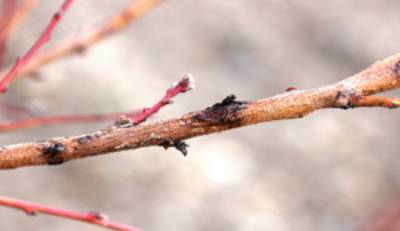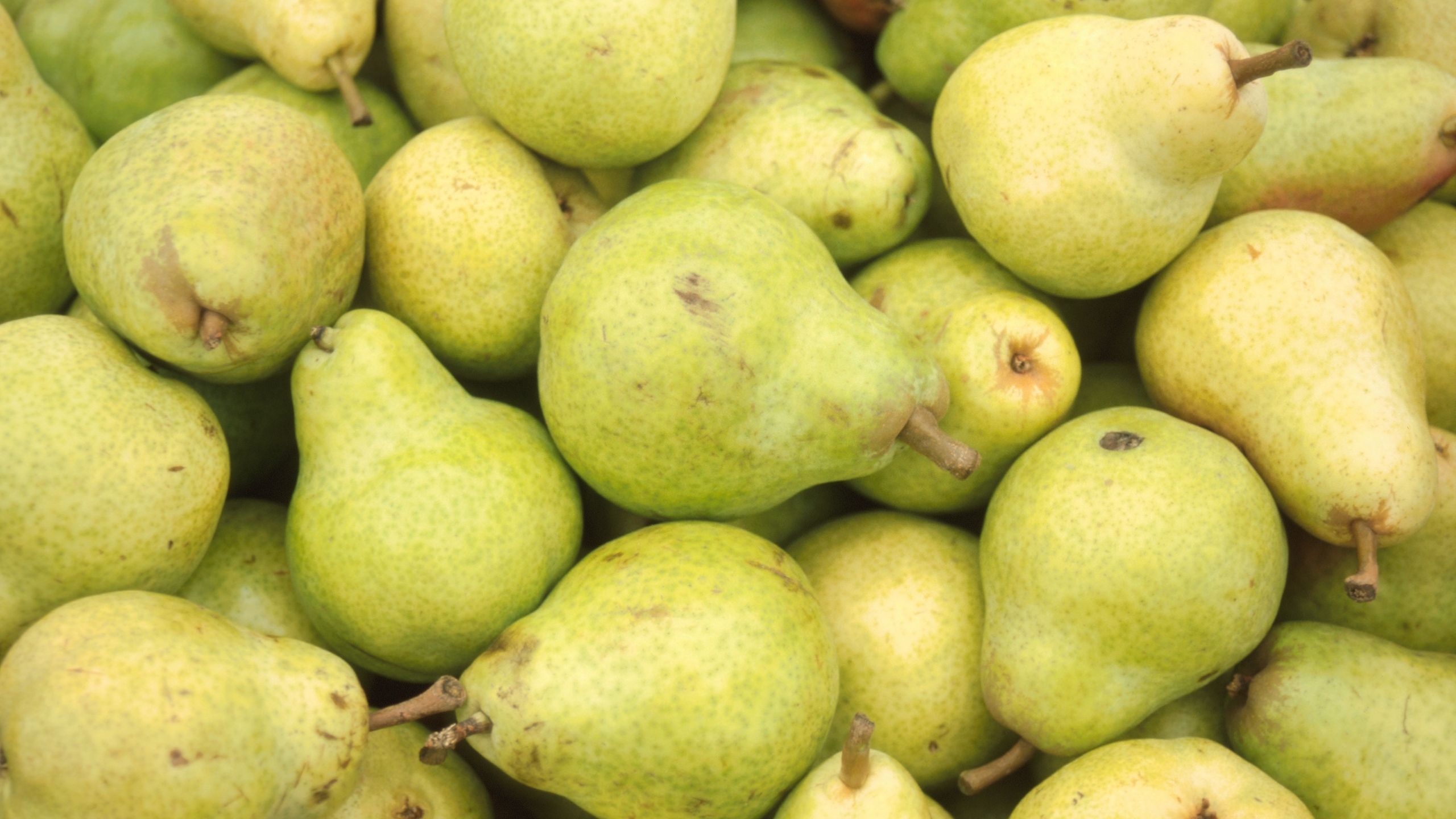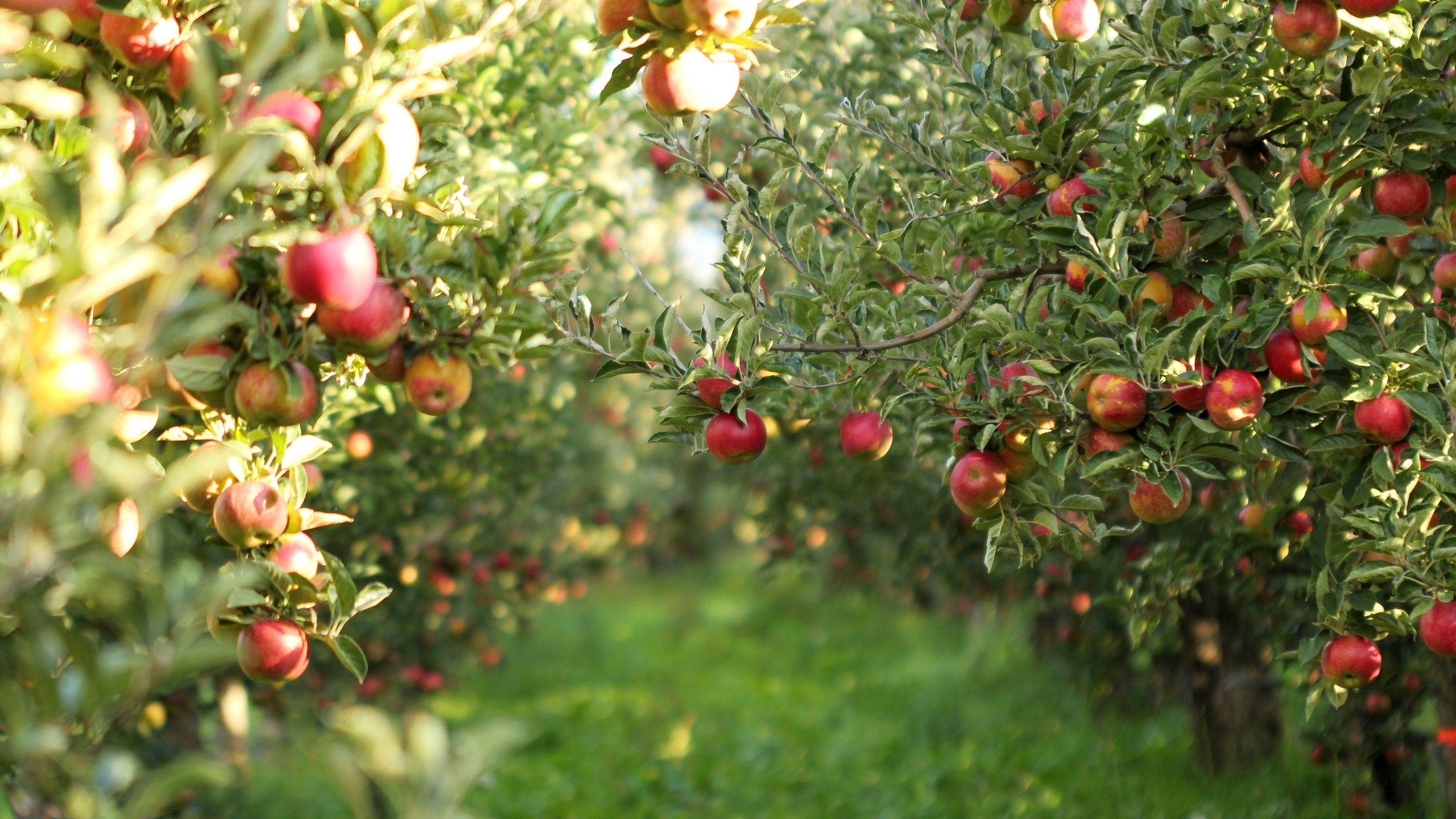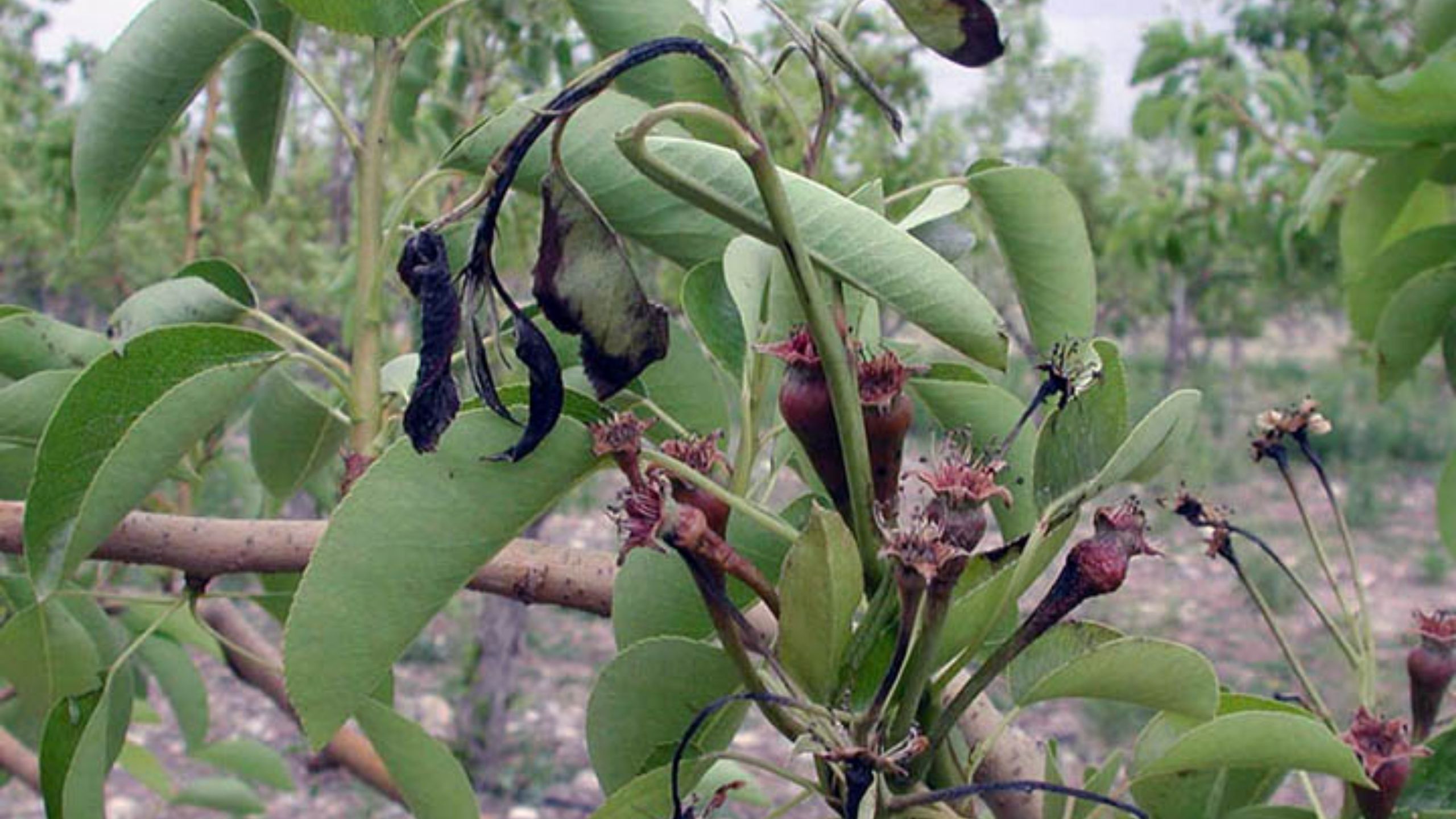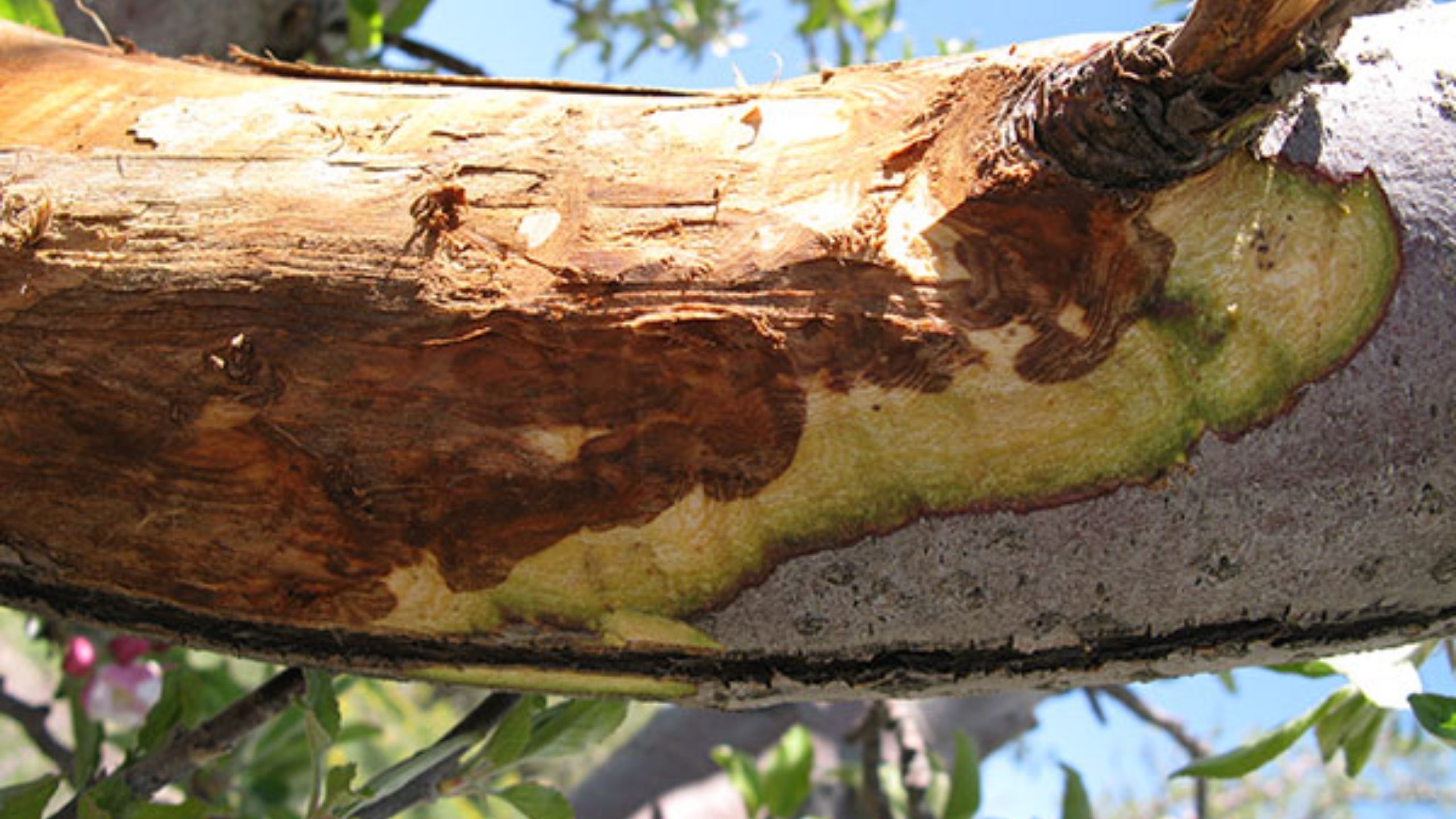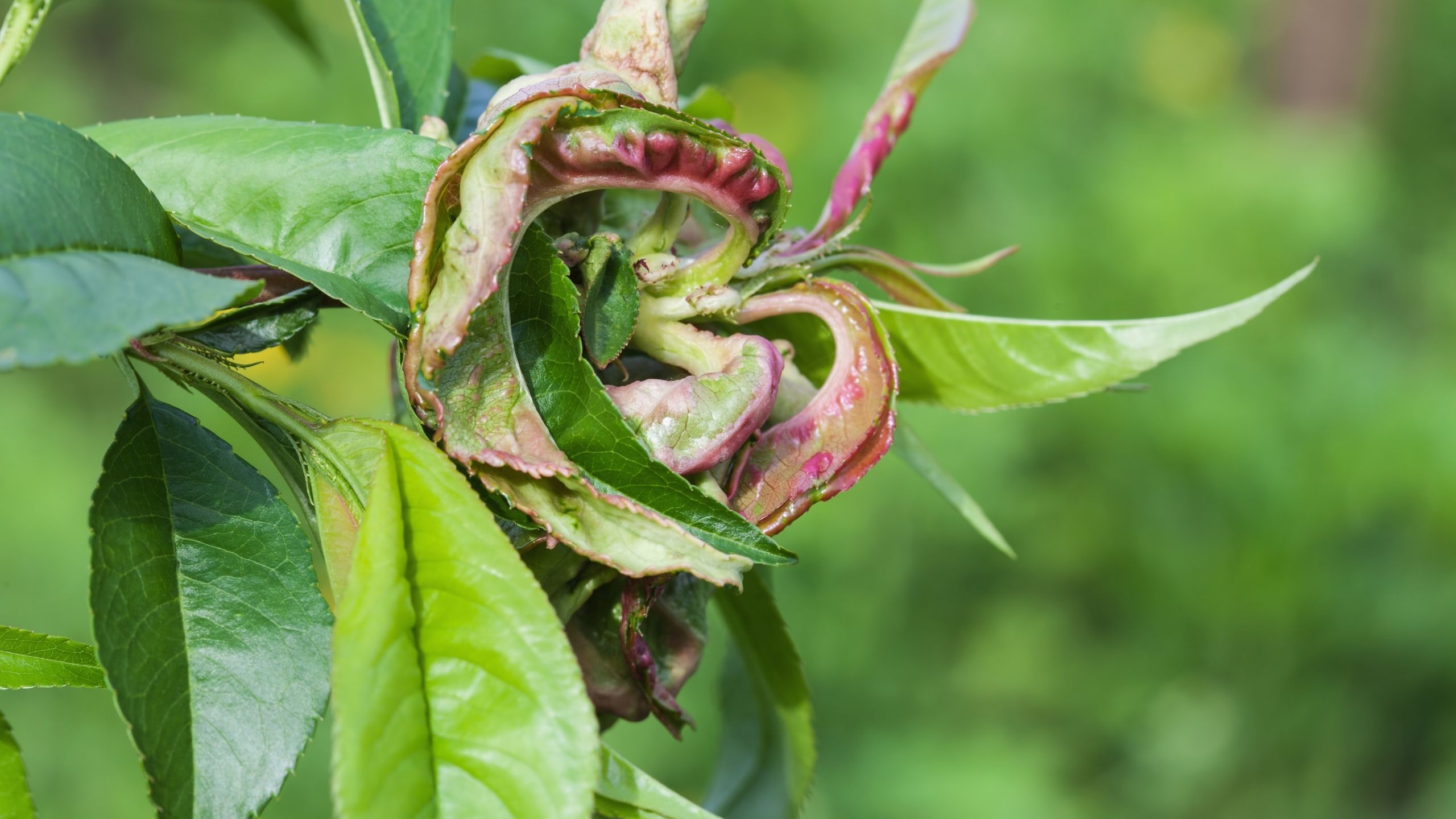Fire Blight in Utah: An Annual Management Guide
June 2021
Marion Murray, IPM Project Leader
Fire blight is a serious disease of apple and pear trees. In the last decade in Utah, there were several seasons where this disease caused extensive losses. The prime conditions for infection require the combination of open blossoms, warm temperatures, and wet weather. Because this disease spreads rapidly and symptoms are not visible until two weeks after infection, it can catch growers off-guard. Having a well-executed and integrated year-round management program can reduce losses from fire blight.
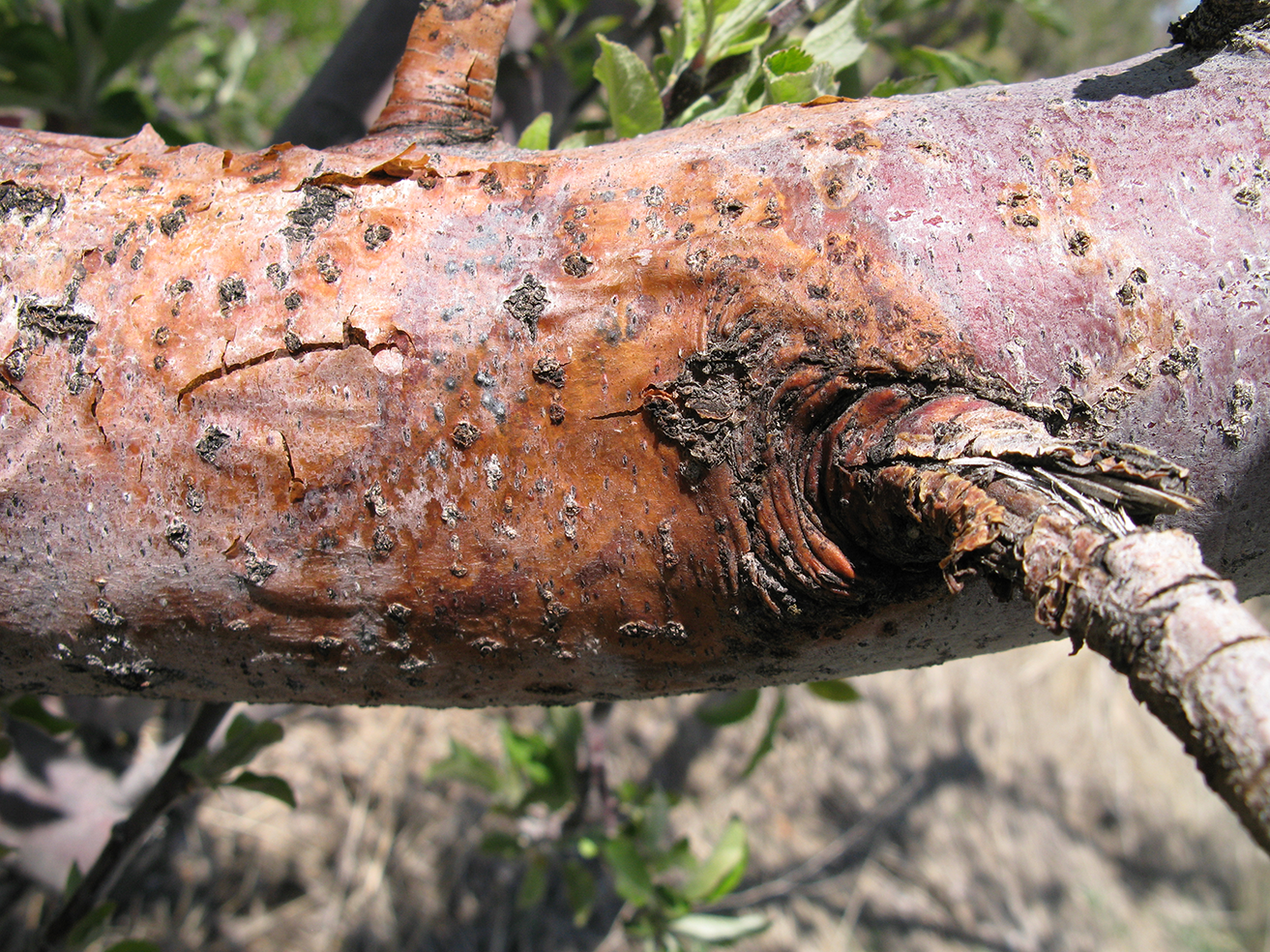
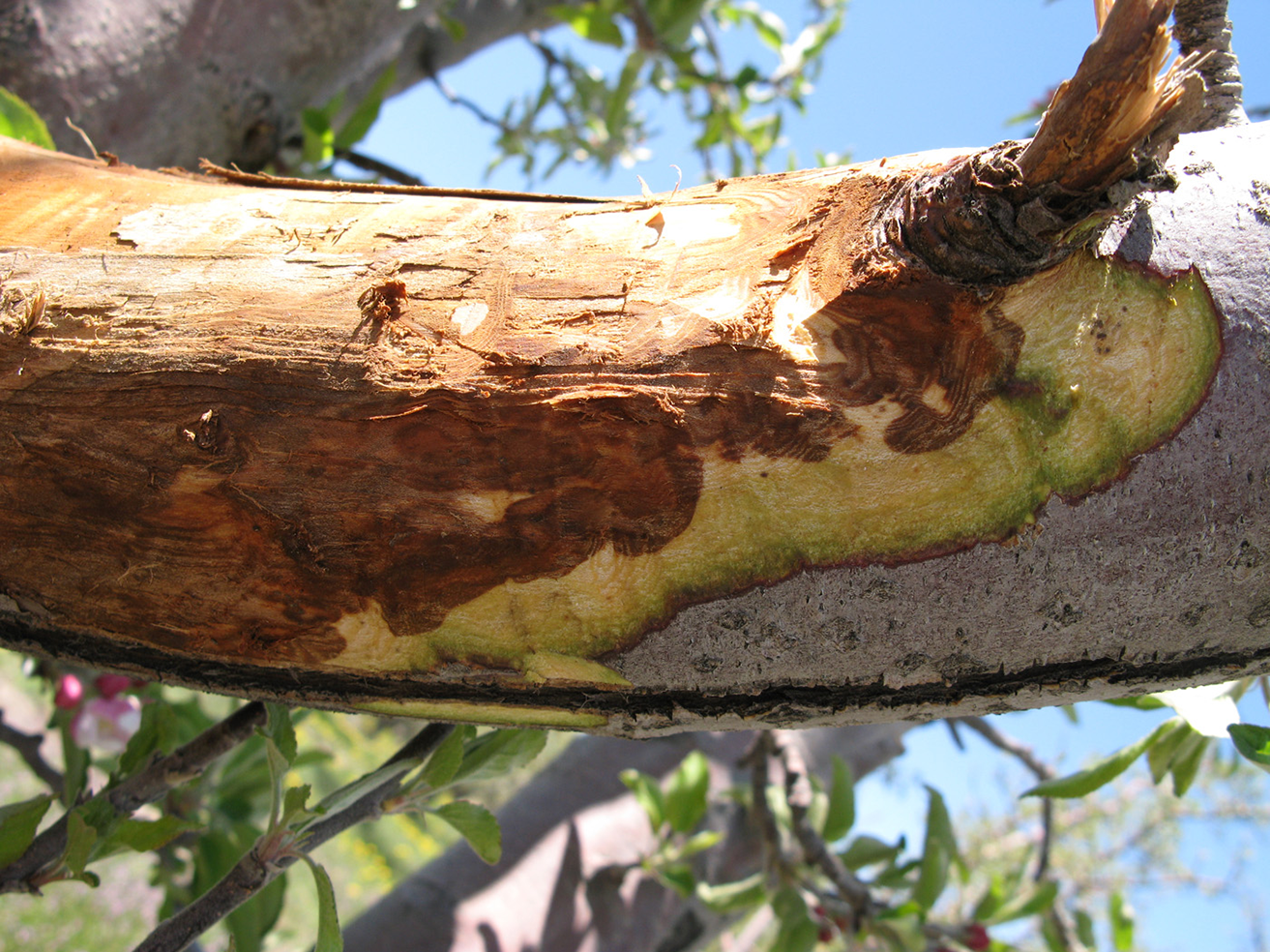
Why Is Fire Blight an Issue?
- Apple varieties grown by commercial producers are driven by consumer demand and include Fuji, Gingergold, Gala, and Honeycrisp. Unfortunately, these varieties are more susceptible to fire blight, especially when compared to the traditional varieties previously grown (McIntosh, Red Delicious, Cortland).
- Most large, commercial apple orchards are planted in a high density. This provides greater yields, but also allows fire blight bacteria to spread rapidly from flower to flower.
- Trees planted in high-density orchards are often on dwarfing rootstocks such as M.9 or M.26 that are susceptible to fire blight.
Fire Blight Biology
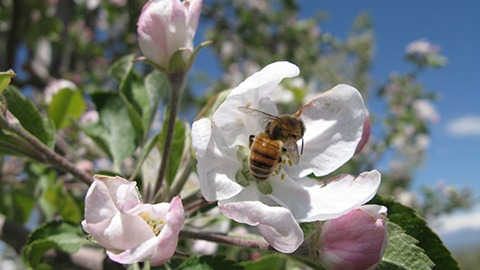
Fire blight is caused by the bacterium Erwinia amylovora. Bacteria survive the winter in cankers (areas of dead bark and phloem killed by fire blight the previous year). Cankers can be small lesions associated with wilted terminals, while others are large areas on scaffold limbs (Fig. 1a/1b). In spring, bacteria multiply and start oozing out of infected plant tissue, colonizing the bark surface. Bacteria become slowly active at 50°F and multiply more rapidly as temperatures increase (Johnson, 2015).
In Utah, the most important infection entry point is through blossoms. Bacteria from the oozing cankers are spread within trees and from flower to flower by winddriven or splashing moisture and by pollinating bees or other insects (Fig. 2). When Erwinia bacteria land on the flower stigma, they multiply rapidly as temperatures warm. Infection occurs when large amounts of bacteria on the stigma are washed into the floral cup by rain, irrigation water, or heavy dew. Just two hours of moisture is needed for infection, and heavy dew plays a big role in Utah in the infection process. Infected flowers wilt and turn brown or black, and bacteria travel within plant tissue to leaves, up succulent shoots, and beyond.
Shoot infections can sometimes occur later in spring or early summer when moisture carries bacteria to foliage injured by hail or other trauma. These infections are not associated with blossom blight or existing cankers but are considered new infections. Once plant tissue hardens off, the risk of shoot blight declines (Johnson, 2015).
As tree growth slows in hot weather, bacterial progress within the tree also slows. In some trees, damage may be minimal, while other trees may be severely injured or killed, especially if bacteria enter a susceptible rootstock (Table 1). In the heat of summer and over the winter, the bacteria “rest” in infected tissue until trees come out of dormancy and temperatures rise the following spring.
Winter
Pruning/Removal

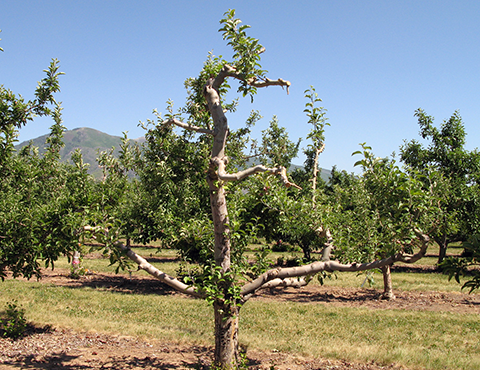
Removal of overwintering cankers from dormant trees is one of the most important steps in managing fire blight. It reduces the amount of inoculum in the orchard, thus reducing future infections.
Prune trees in winter or early spring when the weather is dry. Infected branches are easily identified because the leaves remain attached well into winter (Fig. 3). Limbs with bark that appears wet, off-color, or sunken indicate a canker (Fig. 1a). Cut these limbs at least 8 inches below the visible symptomatic tissue. Pruning crews working in large orchards may need to take multiple passes in the orchard, but the results will pay off. For dormant pruning, tools do not need to be sterilized between cuts (Lecomte, 1990).
Other winter practices include:
- Prune out any 4-inch stubs that were left from pruning the prior summer (see “Summer” section and Fig. 4).
- Remove all dead trees and trees so severely infested where it is impossible to remove all the blighted tissue with pruning.
- Remove all root suckers and rootstock sprouts. If they become infected, they may put the entire tree at risk depending on the rootstock shown on Table 1 (Crassweller & Schupp, 2018).
Winter debris does not need to be burned or chipped and can be left on the orchard floor and mulched. A cut dormant branch on the ground will not be able to spread inoculum the following spring (Johnson, 2015).
Table 1. Dwarfing Apple Rootstock Susceptibility
| Apple Rootstock | Resistance Level | Apple Rootstock | Resistance Level |
|---|---|---|---|
| Bud (B.9) | susceptible | M.7 | resistant |
| B.118 | moderately susceptible | M.9 | highly susceptible |
| Geneva 11 (G.11) | resistant | M.26 | highly susceptible |
| G.16 | highly resistant | M.27 | susceptible |
| G.41 | highly resistant | MM.106 |
moderately resistant |
| G.65 | highly resistant | MM.111 |
moderately resistant |
For more information about resistance, see the tables for apple variety resistance and apple rootstock resistance in the Intermountain Tree Fruit Guide website.
Spring
Copper
The efficacy of copper as a delayed-dormant application has been proven effective by researchers at Oregon State University. They found that copper does not kill bacteria on existing bark cankers, nor does it prevent bacteria from oozing from cankers. It works by providing an inhibitory barrier on bark and buds, preventing widespread colonization of bacteria on these surfaces (Elkins et al., 2015).
A delayed-dormant copper application is applied before bloom, between bud swell (silver tip) and when leaves just start emerging (green tip) (Table 2). Its effect is related to how it is applied and the weather after application. It must be applied as a high-volume spray, thoroughly wetting all exposed surfaces in the orchard, including any resistant trees growing near susceptible trees (e.g., Red Delicious). It should not be applied when temperatures will fall below 45°F that evening.
Studies have not been conducted on the use of copper as a delayed-dormant application in Utah. The grower’s decision to use it at that timing will depend on weather, cost, amount of cankers in the orchard, and personal experience.
Some copper formulations have a lower metallic copper concentration and can be effective as a blossom application (Table 2). Utah State University (USU) researchers have tested several coppers as stand-alone treatments during bloom with limited success.
Table 2. Copper Formulations and Application Timing
| Active Ingredient | Example Brands | % Copper | When to Use |
|---|---|---|---|
| basic copper sulfate | Basic Copper 53, Cuprofix | 20-50% | silver to green tip |
| basic copper sulfate plus copper oxychloride | C-O-C-S | 51% | silver to green tip |
| copper hydroxide | Kocide, Champ, Nu-Cop | 25-50% | silver to green tip |
| copper hydroxide + copper oxychloride | Badge | 20% | silver to green tip |
| copper hydroxide | Previsto | 3% | silver to half-inch green and/ or bloom |
| copper octanoate (“copper soap”) | Cueva, Grotto, Fertilome Copper Soap | 2% | silver to half-inch green and/ or bloom |
| copper sulfate pentahydrate | CS 2005, MasterCop | 5%/td> | silver to half-inch green and/ or bloom |
Predicting Fire Blight Infections
USU provides access to a predictive fire blight tool on the USU Climate Center website at climate.usu.edu/traps for a range of locations in Utah. The tool uses a model developed by Washington State University (WSU) called “Cougarblight,” and is based on several orchard and environmental factors (Smith, 2010):
- Local blight history of the orchard: The presence or absence of blight in the orchard or nearby will affect the risk potential for infection. Infection is most likely to occur if there was fire blight in the orchard or in neighboring orchards last year.
- Daily maximum temperature: Although bacteria can start multiplying at 50°F, the most accelerated bacterial division occurs between 78 and 90°F. To provide a prediction, the tool calculates a “fourday risk value” related to each day’s maximum temperature. Temperatures from four days are used because stigma tips, on which bacteria colonize, are viable for about that long. The four-day value then indicates a risk level of low, caution, high, extreme, or exceptional.
- Moisture: If flower stigmas are colonized with bacteria, infection will not occur without sufficient moisture to wash the bacteria into the floral cup. Although the fire blight model provides a predicted risk level of infection, it does not account for flower-wetting. (Wetting that triggers flower infection happens from a minimum of two hours of rain, dew, or light wetting from any form of sprinkler irrigation.) Therefore, growers should use the predicted risk level in combination with a local weather forecast for rain or check for dew formation to decide on spraying. Keep in mind that a heavy downpour does not seem to trigger infection, perhaps because the blossoms are actually washed free of bacteria colonies (Johnson, 2015).
For a detailed description of the Cougarblight model, how four-day risk values are calculated, and descriptions of risk levels, see the Cougarblight fact sheet provided by WSU (Smith, 2010).
Antibiotic Treatments at Bloom
An antibiotic should only be used based on the results of the fire blight model on the Climate Center website and if moisture is present. Streptomycin (Agri-Mycin and others) is the most effective fire blight antibiotic available, but in parts of Utah, fire blight bacteria have developed resistance, limiting its effectiveness. There are two alternative antibiotics: oxytetracycline (Mycoshield and others) and kasugamycin (Kasumin). Only use antibiotics on open blossoms. They are not effective at any other time (for example, on shoot blight or existing cankers).
- Streptomycin (strep) is effective because it has slight systemic activity, lasts three to four days, and kills the fire blight bacteria. It can be applied up to 24 hours before or after a wetting event. Adding a nonionic surfactant (such as Regulaid) will improve coverage and uptake of streptomycin.
In areas of documented resistance such as Utah County, use streptomycin once per season, and mix it with oxytetracycline in that one use. In areas with no resistance, do not use it more than twice in a row, and consider mixing it with oxytetracycline to avoid resistance. - Oxytetracycline (oxytet) is not as effective as strep because it works by slowing down the division of bacteria rather than killing it. As such, it works best if applied 12-24 hours before a wetting event to target the bacteria before it is washed into the floral cup. Oxytet provides about 3 days of protection.
- Kasugamycin has an efficacy between oxytetracycline and strep, according to Utah trials (Nischwitz, 2019). It provides protection for up to four days and should be used with a nonionic surfactant such as Regulaid. To minimize resistance, the label specifies not applying it in a half-rate or alternate-row application. Kasugamycin does not have a systemic effect, so it must be applied before wetting events.
It is important to remember that not all trees bloom together and late blooms occur even within cultivars. Late-blooming flowers often coincide with hotter temperatures, increasing the risk for infection at a time when growers stop thinking about fire blight. As long as the Climate Center fire blight model predicts risk, there are open blossoms present, and there will be two hours of moisture, an antibiotic should be applied to prevent infection.
Biologicals Plus Antibiotics
There are several organic products labeled for fire blight suppression. Most of these products are made from other living organisms and are called “biological” pesticides. In Utah trials, using a biological alone has not shown to be effective in preventing fire blight. Biologicals are best used by combining or alternating with antibiotics. In areas of streptomycin resistance, biologicals can help oxytetracycline or kasugamycin work more effectively.
Biologicals work by competing for space and nutrients on the flower stigma, or by preventing fire blight bacteria from multiplying. They must be present on the flower stigmas before the fire blight bacteria arrive.
For best effect, follow the label recommendation when using biologicals. Some common points include:
- Increase water volume to 200 gal/acre. Trees must be wet for the biological to get started.
- Application for most products starts when 10-30% of flowers are open, and repeated on a regular schedule, unless noted on the label.
- Apply in early morning when temperatures are in the low 60s. Below 50°F, biologicals are ineffective and will die. The biological should colonize the flower before the fire blight bacteria have had a chance. A warm day following application is perfect.
- Do not mix other pesticides with biologicals unless written on the label.
- Continue to watch the Cougarblight model and follow with an antibiotic when risk levels are high and two hours of moisture is expected. To apply streptomycin, wait 1 day after biological application, and to apply oxytetracycline, wait 2 days after biological application.
- Do not apply biologicals after fruit-set.
Examples of biological pesticides available in Utah include the following. (This is not a comprehensive list nor an endorsement of products). Some can be tankmixed to improve antibiotic activity (check the label) or used in rotation.
- Aureobasidium pullulans strain DSM 14940 (Blossom Protect) is a yeast-like fungus that was first isolated from apple orchards. It works by competing with the fire blight bacteria for nutrients and space. It successfully colonizes the hypanthium (floral cup), and although the label states starting application at 10% bloom, it has the greatest effect when applied at full or late bloom due to the strong competition for space (Pusey et al., 2009; Johnson & Temple, 2013). It should be applied in combination with a buffer (sold with the product) and reapplied after a downpour.
- Bacillus subtilis (Aviv, Serenade) is a grampositive bacterium. Although the Bacillus bacteria compete for space on flowers, the major effect is the pre-formed antimicrobial compounds that are toxic against fire blight bacteria. While the label recommends starting application at 1–5% bloom, Oregon research has shown improved efficacy by applying it later in bloom when fire blight bacteria are present (Johnson & Temple, 2013). Utah trials using Serenade Opti have found fair to good results (Murray & Nischwitz, 2020).
- Bacillus amyloliquefaciens (Double Nickel, Serifel, Stargus, Triathlon) is a gram-positive, commonly found soil bacterium with pre-formed antimicrobial compounds that inhibit growth of fire blight bacteria. It provides poor control of fire blight when used alone but can be rotated with an antibiotic.
- Pantoea agglomerans strain E325 (Bloomtime Biological) is a gram-negative, commonly occurring orchard bacteria. It works by colonizing the flower stigma and thus competing for space. Thorough coverage is important. It is a poor control option as a standalone product, but when applied at early bloom, and followed by an antibiotic, it can help improve efficacy of control.
- Pseudomonas fluorescens strain A506 (BlightBan) only works on blossoms that are open at the time of application, so thorough coverage is important.
Adding biologicals to your fire blight arsenal will certainly increase production costs, but where streptomycin is proving less and less effective, it may be a good option and could help prevent losses in the orchard (Johnson & Temple, 2013). New alternatives are continually evaluated, and in the future, there may be additional effective products.
Control of Shoot Blight
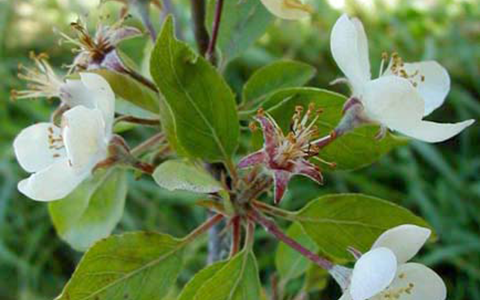
The growth regulator Apogee (prohexadione calcium) can be used to control shoot blight (but not blossom blight). Apogee does not affect the pathogen directly and is not a substitute for an antibiotic or biological during bloom for blossom blight control. Apogeetreated shoots develop hard cell walls, which physically block the spread and growth of Erwinia bacteria, reducing their buildup within the tree during late spring and summer.
The decision to use Apogee is based on past blight history, tree vigor, and age. Where infections are high, and antibiotics and pruning are not proving effective, Apogee can help to lessen tissue death within trees. Because Apogee is a growth retardant, it will stop new shoot growth and may result in reduced fruit size and return bloom. Apogee costs about $40–60 per acre.
To be effective, Apogee is applied at 18–36 ounces per acre in 300 gallons (dilute spray) at late bloom or early petal fall, with a follow-up application three to four weeks later only on very vigorous trees (Fig. 5). Use a nonionic surfactant such as Regulaid to improve coverage. It takes 10 days to two weeks for the first application to take effect against fire blight. Using Apogee later than recommended is not effective against fire blight.
Summer
Prune New Infections
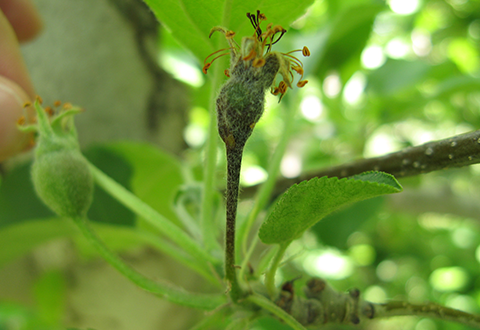
Where possible, pruning crews should be sent through the orchard on a regular basis to prune out new fire blight infections. Early detection and removal are the most effective management strategy, slowing the spread of fire blight and reducing inoculum. If crews can catch blossom strikes just as they begin (i.e., the leaves/flowers are just starting to turn color and wilt and the visible symptoms are no longer than 2 inches), the amount to remove should be double the length of the visible symptoms (Fig. 6). If the infection is older, find the edge of the canker (based on discoloration of the bark) and prune 10 to 12 inches beyond that.
Prune only in dry weather. Ideally, disinfect pruning tools between cuts with disinfecting spray or wipes (least damaging to metal), Pine-sol spray, or a spray of 10% bleach (Teviotdale et al., 1991). However, if proper cuts are made well beyond the infection and into healthy wood (by experienced workers), disinfection is not required (Ontario OMAFRA, 2021). If the weather has become hot and dry at the time of pruning, debris can be left on the orchard floor and mowed. Otherwise, remove and burn debris right after pruning.
Prioritize orchards for pruning, whether it was a low or high fire blight season. For example, Peter (2020) recommends the following priority ranking, based on scouting fire blight damage on a per-row basis:
| Highest Priority | Young orchards 3 – 8 years old with just a few strikes. |
|---|---|
| Young orchards 3 – 8 years old with several strikes. | |
| Older orchards with a few strikes. | |
| Lowest Priority | Orchards with so many strikes that most trees need to be removed. |
Where large, old cankers are being removed in the summer, cut back to at least 3-year-old wood and consider leaving a 4- to 6-inch stub rather than pruning directly back to the main trunk or scaffold. The fire blight bacteria will continue growing 1 to 2 inches beyond the cut surface, and the stub can be removed that winter (Peter, 2020). Some call this the “ugly stub” method.
Where infections are more severe, and older wood is affected, it is best to wait until winter to do a thorough pruning. Heavy tree pruning during the growing season stimulates tree growth and could result in increased bacterial spread within the tree (Johnson, 2015).
Actigard for High-Value Trees
Where fire blight has affected a young, high-value orchard, consider an Actigard application after pruning. The application itself is time-consuming, and the product is expensive, but it could prevent the loss of an orchard.
Actigard (acibenzolar-S-methyl) triggers the plant’s defense system by mimicking the plant hormone, salicylic acid, which is responsible for priming a resistance response. The granular product is mixed with water and a penetrant (such as PentraBark) and handsprayed (or painted) onto the bark of the tree right after pruning. For each pruning cut, the spray should cover the cut, the length of the remaining branch, and about 30 inches of the main trunk adjacent to the branch (avoid spraying the foliage). One quart of Actigard will treat approximately 500 cuts, and it should not be applied within 60 days of harvest.
Research by Johnson and Temple (2016) found that an Actigard application reduced both the proportion of trees in which fire blight came back as well as the rate of canker expansion. In Utah, similar yet preliminary research by Murray & Nischwitz (2020) has shown promising results of Actigard in reducing regrowth of fire blight after pruning as compared to a water-only spray.
References
- Elkins, R., Temple, T. N., Shaffer, C. A., Ingels, C. A., Lindow, S. B., Zoller, B. G., & Johnson, K. B. (2015). Evaluation of dormant-stage inoculum sanitation as a component of a fire blight management program for fresh-market Bartlett pear. Plant Disease, 99(8), 1147–1152.
- Crassweller, R. & Schupp, J. (2018, March 21). Apple rootstocks: Capabilities and limitations. [Fact sheet]. The Pennsylvania State University Extension.
- Johnson, K. B. (2015). Fire blight of apple and pear. The Plant Health Instructor. The American Phytopathological Society. DOI: 10.1094/PHI-I-2000-0726-01
- Johnson, K. B., & Temple, T. N. (2016). Comparison of methods of Acibenzolar-S-Methyl application for post-infection fire blight suppression in pear and apple. Plant Disease 2016 100(6), 1125– 1131.
- Lecomte, P. (1990). Risk of fire blight infection associated with pruning of pear trees. Acta Horticulturae, 273, 83–89.
- Murray, M. & Nischwitz, C. (2020). [Unpublished raw data on fire blight trials in Utah]. Utah State University Extension.
- Nischwitz, C. (2019). [Unpublished raw data on fire blight trials in Utah]. Utah State University Extension.
- Ontario Ministry of Agriculture, Food and Rural Affairs (OMAFRA). (2021). Fire blight. Excerpt from Publication 310, Integrated Pest Management for Apples.
- Peter, K. (2020, July 9). Improving late season fire blight and brown rot management. Fruit Growers News.
- Pusey, P. L., Stockwell, V. O. & Mazzola, M. (2009). Epiphytic bacteria and yeasts on apple blossoms and their potential as antagonists of Erwinia amylovora. Phytopathology, 99, 571–581.
- Smith, T. (2010). The development and use of Cougarblight: A situation-specific fire blight risk assessment model for apple and pear. [Fact Sheet] Washington State University Extension.
- Teviotdale B., Wiley, M. & Harper, D. (1991). How disinfectants compare in preventing transmission of fire blight. California Agriculture 45(4), 21–23.


